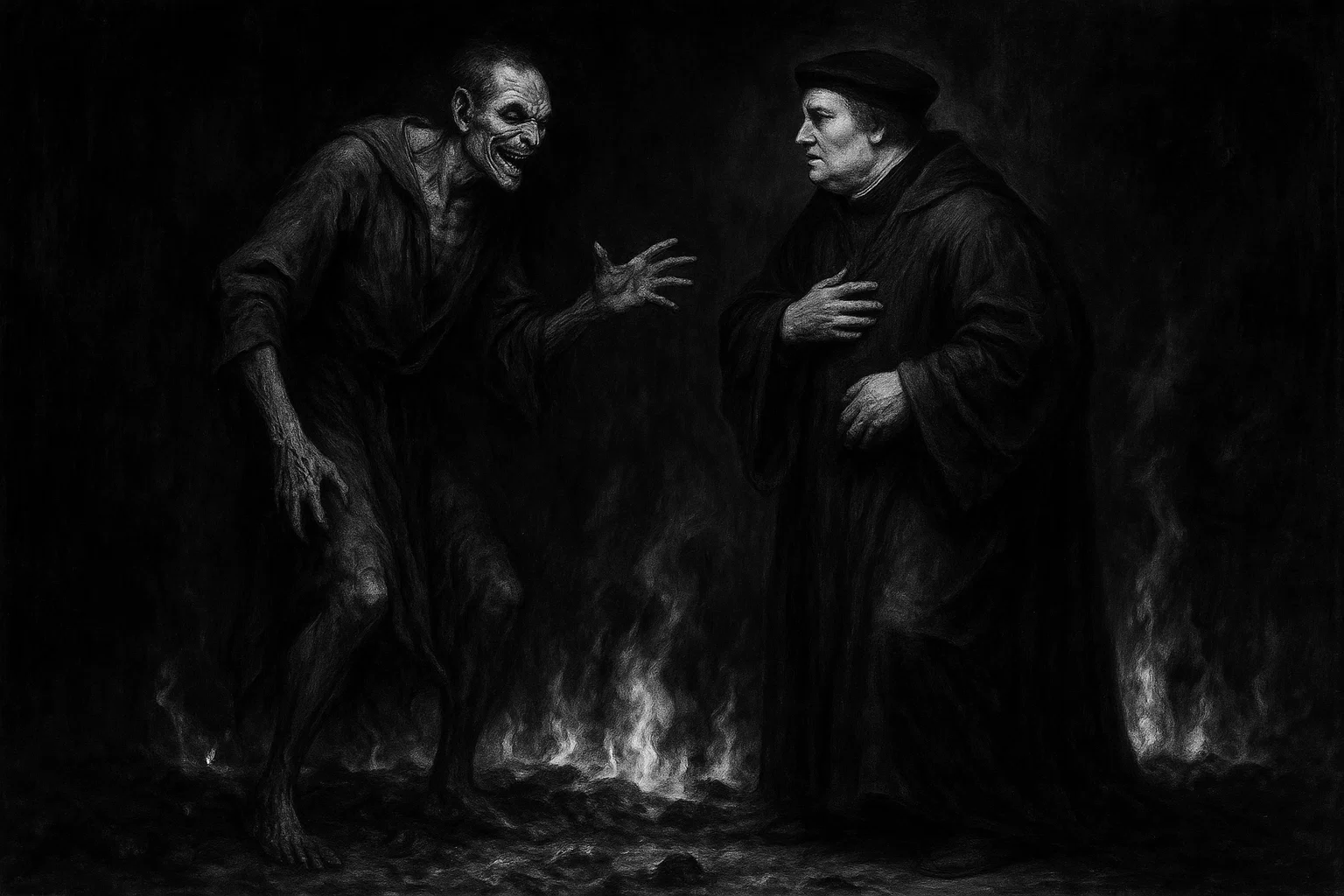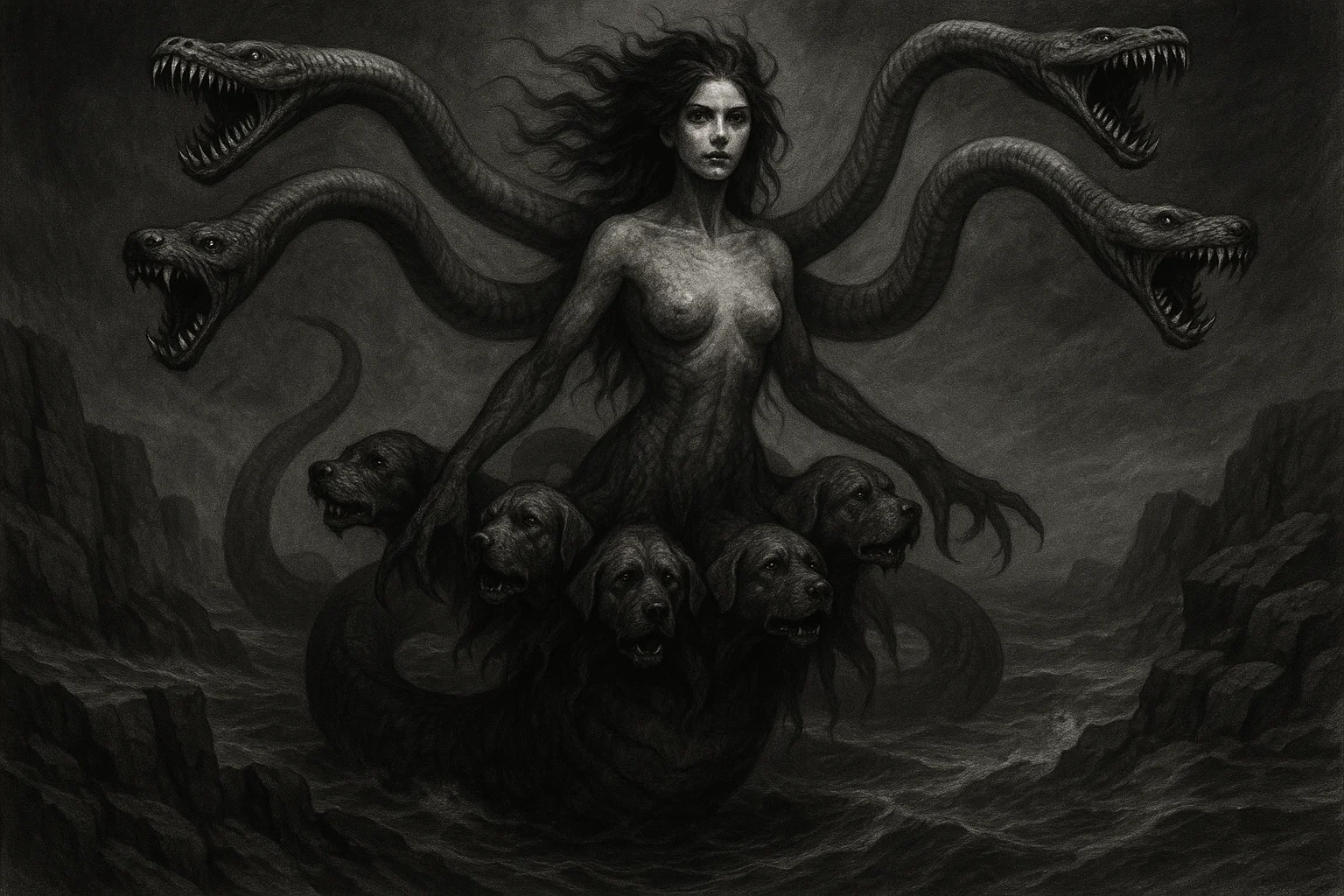In the shadowy depths of demonology, where forbidden knowledge tempts the unwary soul, Caim lurks as a master of deception and dark enlightenment. This Great President of Hell, also known as Camio or Caym, commands legions with a voice that echoes through nature’s hidden tongues, drawing mortals into webs of corruption. What if a demon could grant you the ability to converse with birds or unravel the threads of fate—would you risk your eternal soul for such perilous gifts?
Caim‘s allure lies in his promise of intellectual supremacy, yet his offerings come laced with malice, leading summoners down paths of pride and ruin. As a fallen angel from the ancient Order of Angels, he embodies the fall from grace, twisting divine wisdom into tools of temptation. Have you ever wondered how a being of such cunning navigates the hierarchy of Hell, or what ancient echoes resonate in his name?
This exploration uncovers the malevolent essence of Caim, a demon whose influence seeps into the cracks of human ambition. From his origins in grimoires to his role in corrupting minds, Caim represents the dangers of unchecked curiosity. Delve deeper to discover the truths—and traps—hidden within his infernal domain.
Summary
Key Information
| Attribute | Details |
|---|---|
| Name | Caim, Camio, Caym, Qayin variant |
| Title | Great President of Hell, Grand Master of Hell, Thrush President, Deceiver of Tongues |
| Gender | Male |
| Role | Disputer, diviner, teacher of animal languages and future knowledge, tempter through intellect |
| Hierarchy | President (mid-tier rank below Kings and Dukes, above Knights), commands 30 legions |
| Servitors | Commands 30 legions of demons (specific servitors unnamed, but include spirits of deception and nature manipulation) |
| Superior Demon | Amaymon (King of the South), potentially Lucifer or Paimon as overarching lords |
| Powers | Understanding animal voices (birds, cattle, dogs, waters), divination, dispute mastery, invisibility, astral projection, wit enhancement |
| Appearance | Initially a black thrush, transforms into a man with a sharp sword; sometimes adorned with a peacock’s tail, tuft, gold bands, jewelry, or headdress; answers on burning ashes or coals |
| Etymology | Derived from biblical “Cain” (Qayin), Gaelic “Cai” (Sir Kay), Hebrew “Chium” (Assyrian/Babylonian epithet), or Latin terms for “sword” or “voice” |
| Associated Figures | Martin Luther (debated encounter), King Solomon (bound in brass vessel), Cain (synchronized archetype), Cernunnos (speculative nature link) |
| Weaknesses | Compelled to truth on burning ashes or coals, vulnerable to opposing angels like Nanael or Chajakiah |
| Opposing Angel/Saint | Nanael (Kabbalistic), Chajakiah (Rudd system), Saint Michael for general protection |
| Equipment/Tools | Sharp sword (symbol of rhetoric), burning ashes or coals for divination, sigil for summoning |
| Pantheon | Christian Demonology (Ars Goetia, Pseudomonarchia Daemonum), with speculative ties to Celtic and Babylonian traditions |
Etymology
The name Caim weaves a tangled etymological web, reflecting his deceptive nature across cultures and languages. Primarily linked to the biblical Cain—or Qayin in Hebrew, meaning “smith” or “acquired”—this connection portrays Caim as an archetype of fratricide and rebellion against divine order.
Cain‘s curse of wandering and marking aligns with Caim‘s role as a fallen angel, exiled from heavenly grace, using knowledge to sow discord among humans.
Alternative roots trace to the Gaelic Cai, referencing Sir Kay from Arthurian legends, a stern knight known for sharp tongue and guardianship. This Celtic tie suggests Caim as a corrupted guardian spirit, perhaps echoing pre-Christian entities like Cernunnos, the horned god of animals and wilderness.
In Hebrew, Chium emerges as a possible source, an epithet for Assyrian or Babylonian deities associated with war and prophecy, hinting at Mesopotamian influences where demons were intermediaries between gods and mortals.
Latin derivations propose links to “caedere” (to cut, fitting his sword) or “vox” (voice, matching his animal communication). Transcription variations like Camio or Caym arise from medieval grimoires’ linguistic shifts, possibly corrupted from “Chamos,” a Moabite god equated with Baal-Peor, known for divination and sacrifice.
These multifaceted origins underscore Caim‘s identity as a demon of transformation, blending murderous legacy, heroic sternness, and ancient prophetic roles into a singular force of corruption.
Speculative scholars connect Caim to Egyptian concepts, such as Thoth’s ibis form for wisdom, twisted into avian deception, or Set’s chaotic communication. Babylonian ties through Chium evoke Enki’s waters and wisdom, perverted into infernal noise. This etymological diversity highlights Caim‘s adaptability, luring seekers with promises of understanding while masking his malevolent intent.
You May Also Like: Buer: The Demon of False Healing and Twisted Wisdom
What Does the Demon Caim Look Like?
Caim‘s visage is a chilling blend of natural innocence and martial threat, designed to disarm before striking. He manifests first as a black thrush, a seemingly harmless bird with glossy feathers and a melodic yet ominous song, symbolizing hidden malice beneath beauty. This form allows stealthy approach, whispering temptations unnoticed.
Upon command, Caim shifts into a humanoid figure—a well-built man wielding a sharp sword, its blade gleaming with infernal edge. Adornments include a peacock’s tail or tuft, signifying pride and vanity, alongside wings banded in gold dust and abundant jewelry, exuding false grandeur. His eyes burn with cunning intelligence, and when divining, he stands amid burning ashes or coals, flames licking without harm, evoking Hell’s eternal fires.
In some depictions, a headdress crowns him, enhancing his presidential stature, while his aura pulses with deceptive charm. This duality—bird to armed man—mirrors his powers, transitioning from subtle influence to overt confrontation, always veiling his corrupting essence.
Historical and Mythological Background
Caim‘s origins root in the fallen angels narrative, cast from the Order of Angels for rebellion, as chronicled in Judeo-Christian demonology. Emerging in medieval grimoires, he embodies corrupted celestial wisdom, drawing from ancient animistic beliefs where spirits mediated nature and fate. His inclusion in Solomon’s bindings suggests pre-Christian roots, possibly as a nature deity demonized by monotheistic scribes.
Connections span worldwide: To biblical Cain, whose murderous act parallels Caim‘s disputatious temptations, some practitioners synchronize them as avatars of primal sin. Celtic links via Cai evoke Sir Kay’s guardianship, twisted into infernal oversight, perhaps echoing Cernunnos, the stag-horned god of beasts, whose animal dominion Caim perverts. Babylonian influences through Chium tie to Enki, god of waters and craft, corrupted into deceptive voices.
Egyptian echoes appear in Thoth, ibis-headed scribe of knowledge, mirrored in Caim‘s avian form and divination, but inverted to chaotic ends. Mesopotamian demons like Pazuzu, wind spirits, share elemental communication, while Moabite Chamos (Baal-Peor) adds sacrificial prophecy. These global threads portray Caim as a amalgamated evil, absorbing ancient deities’ attributes to amplify his corrupting reach.
The Binding by King Solomon
Legends from the Testament of Solomon depict Caim among 72 demons ensnared in a brass vessel, compelled to build the temple. Solomon exploited Caim‘s animal understanding for construction insights, but the demon subtly sowed doubt among workers, tempting with future visions of downfall. This tale illustrates Caim‘s insidious influence, turning servitude into subversion.
Encounter with Martin Luther
Apocryphal accounts narrate Caim‘s confrontation with reformer Martin Luther, manifesting as a sophisticated disputant. Caim challenged Luther’s theology with sophistry, aiming to erode faith through intellectual traps. Standing on coals, Caim offered forbidden knowledge, but Luther’s resolve repelled him, highlighting the demon‘s role in tempting scholars toward heresy.
You May Also Like: Botis in Demonology: From Serpent to Hell’s Noble
The Ornithologist’s Temptation
In a modern legend, ornithologist Julian summoned Caim to track rare birds, using the demon’s sigil and feather offering. Caim granted avian language comprehension, leading to discoveries—but at a cost: Julian’s growing obsession isolated him, corrupting his pursuit into solitary madness, exemplifying Caim‘s gifts as curses.
Links to Cain’s Legacy
Synchronized with Cain, Caim embodies the wanderer’s curse, tempting with smith-like craft in rhetoric. In some myths, Caim whispers to Cain‘s descendants, perpetuating cycles of violence through prophetic lies, reinforcing his as a harbinger of familial strife.
Celtic and Nature Deity Parallels
Speculative ties to Cernunnos portray Caim as a darkened forest spirit, corrupting animal bonds into tools of espionage and betrayal. Interactions with fairy-like entities in Celtic lore show Caim allying for mischief, luring humans into wilds with false guidance.
Historical Mentions
| Text/Grimoire | Year | Description | Excerpt |
|---|---|---|---|
| Pseudomonarchia Daemonum | 1577 | Portrays Caim as a president appearing as a thrush, then sword-bearing man, expert in disputes and animal sounds. | “Caim [Caym] is a great president, taking the forme of a thrush [blackbird], but when he putteth on man’s shape, he answereth in burning ashes, carrieng in his hand a most sharpe swoord, he maketh the best disputers, he giveth men the understanding of all birds, of the lowing of bullocks, and barking of dogs, and also of the sound and noise of waters, he answereth best of things to come, he was of the order of angels, and ruleth thirtie legions of divels.” |
| Ars Goetia (Lesser Key of Solomon) | ~1650 | The 53rd spirit, a president teaching animal voices and future truths, nocturnal and powerful in December. | “The Fifty-third Spirit is Camio, or Caim. He is a Great President, and appeareth in the Form of the Bird called a Thrush at first, but afterwards he putteth on the Shape of a Man carrying in his Hand a Sharp Sword. He seemeth to answer in Burning Ashes, or in Coals of Fire. He is a Good Disputer. His Office is to give unto Men the Understanding of all Birds, Lowing of Bullocks, Barking of Dogs, and other Creatures; and also of the Voice of the Waters. He giveth True Answers of Things to Come.” |
| Dictionnaire Infernal | 1818 | Depicts Caim as a superior demon, thrush-formed then human, sharp-sabered, the cleverest sophist in Hell. | “Caym, démon de classe supérieure, grand président aux enfers ; il se montre habituellement sous la figure d’un merle. Lorsqu’il paraît en forme humaine, il répond du milieu d’un brasier ardent ; il porte à la main un sabre effilé, C’est, dit-on, le plus habile sophiste de l’enfer; et il peut, par l’astuce de ses arguments, désespérer le logicien le plus aguerri.” |
Caim’s Powers and Abilities
Caim‘s arsenal centers on intellectual and perceptual manipulation, distinguishing him from brute-force demons. His core ability—deciphering voices of birds, cattle, dogs, and waters—allows summoners to eavesdrop on nature’s secrets, but he twists this into paranoia, convincing users that whispers foretell betrayal.
As a master disputer, Caim enhances rhetoric, enabling victories in arguments, yet fosters arrogance that isolates and destroys relationships.
Divination provides true answers to future queries, compelled on burning coals, but Caim frames revelations to incite greed or fear, driving mortals to immoral acts. Invisibility cloaks users for secrecy, tempting espionage and theft. Astral projection and beast-form assumption, drawn from occult extensions, lure into dream-realm dangers, blurring reality and leading to madness.
In pop culture adaptations, like the Shin Megami Tensei series, Caim (as Camio) wields fire-based attacks and negotiation skills, reflecting his fiery element and sophistry. These newer portrayals amplify his corruption, using digital mediums to tempt players with virtual power. Overall, Caim deploys powers subtly, corrupting through overreliance on forbidden insight, eroding moral foundations.
Powers and Abilities Breakdown
| Power/Ability | Description | Source | How It Tempts/Corrupts Humans | Countermeasure |
|---|---|---|---|---|
| Animal Voices Comprehension | Decodes songs of birds, lowing of bullocks, barks of dogs, and water noises | Ars Goetia, Pseudomonarchia Daemonum | Instills false sense of nature dominion, leading to isolation | Invocation of Nanael, nature humility rituals |
| Divination | Delivers accurate past/present/future insights, especially on coals | Ars Goetia, Dictionnaire Infernal | Provokes obsession with fate, prompting unethical choices | Saint Michael prayer, holy water |
| Dispute Mastery | Boosts debating wit, outwitting opponents | Pseudomonarchia Daemonum | Breeds intellectual hubris, manipulating others for personal gain | Humility exercises, angelic seals |
| Invisibility | Grants unseen presence for stealth | Occult extensions | Encourages deceit, spying, and moral erosion | Protective circles, exorcism |
| Astral Projection | Enables out-of-body travel and dream flight | Modern occult lore | Blurs reality, fostering addiction to illusory power | Grounding meditations, Chajakiah invocation |
| Beast Form Assumption | Teaches shifting into animal shapes | Witchcraft traditions | Tempts with primal urges, losing humanity | Faith-based anchors, obsidian crystals |
How to Counter Caim’s Powers
Resisting Caim‘s insidious influence demands spiritual fortitude and ritual precision. His animal voices power falters against grounding rituals, like meditating with earth elements to reaffirm divine creation over demonic perversion. Invoking Nanael, the Kabbalistic angel of knowledge, disrupts his communicative hold, restoring clarity.
For divination, holy water sprinkled in protective circles severs infernal foresight, while prayers to Saint Michael shield against tempting visions. Dispute mastery yields to humility practices, such as silent contemplation, preventing ego inflation. Invisibility counters via angelic seals or mirrors reflecting truth.
Astral projection and beast forms require obsidian crystals for anchoring the soul, combined with exorcism chants. Overall, faith in higher powers, like Chajakiah from Rudd’s system, and avoidance of summoning sigils provide comprehensive defense against Caim‘s corrupting arsenal.
You May Also Like: Balberith: The Infernal Scribe Who Tempts Humanity
Caim’s Role in the Hierarchy of Hell
Within Hell’s rigid structure, Caim serves as a Great President, a rank denoting administrative oversight in infernal affairs, akin to a convocation leader. Positioned mid-hierarchy—below Kings like Baal or Paimon, and Dukes like Aim—but above Knights, he governs scholarly and divinatory domains, perhaps a fiery realm where echoes of animal cries and prophetic flames torment souls.
Commanding 30 legions, Caim deploys armies of deceptive spirits for espionage and temptation, unnamed but specialized in rhetoric and nature manipulation. Superiors include Amaymon, King of the South, directing his elemental fire, and ultimately Lucifer, the overarching emperor. Notable allies encompass fellow presidents like Haagenti, sharing alchemical knowledge, or Buné for eloquence, forming cabals of intellectual corruption.
Adversaries arise among higher ranks, like Paimon for overlapping sciences, or opposing demons in territorial disputes. His relationships foster alliances for broader schemes, yet breed rivalries, reflecting Hell’s chaotic order. Caim‘s role amplifies his malevolence, using hierarchy to extend corrupting influence across infernal and mortal planes.
Astrological Associations and Symbolism
Caim‘s astrological ties amplify his deceptive intellect, aligning with Mercury for communication and cunning, and Sun for illuminating hidden truths—perverted into blinding illusions.
Zodiacally, he resonates with Sagittarius (20-24 degrees, December 12-16) for exploratory wisdom, and alternatively Pisces (10-20 degrees, March 1-10) or Virgo (September 13-17) in varying systems, emphasizing duality and analysis.
Symbolism abounds: The thrush evokes eloquent deception, sword sharp rhetoric, peacock tail vain pride. Elements include Fire for transformative passion and Air for swift communication, with Earth in some attributions for grounded manipulation. Metals like Mercury (fluidity) and Gold (corrupting allure) suit his nature, while crystals such as citrine (clarity twisted) and black tourmaline (protection, ironically) associate.
Colors range from orange (vitality) to green (nature) and black (mystery). Incense like storax aids invocation, days Wednesday for Mercury influence. These associations enhance Caim‘s summoning, but symbolize his traps of false enlightenment.
| Astrological/Symbolic Element | Association | Meaning |
|---|---|---|
| Element | Fire, Air, Earth | Destruction, intellect, stability perverted |
| Zodiac | Sagittarius, Pisces, Virgo | Exploration, intuition, precision |
| Planet | Mercury, Sun | Communication, illumination |
| Month/Dates | December (12-16), March (1-10), September (13-17) | Power peaks in introspection periods |
| Metal | Mercury, Gold | Adaptability, false wealth |
| Color | Orange, Green, Black | Energy, growth, shadow |
| Crystal | Citrine, Agate, Black Tourmaline, Obsidian | Clarity, protection, grounding |
| Incense | Storax, Sandalwood | Invocation, spiritual deception |
| Day | Wednesday | Mercurial influence |
| Tarot Card | 9 of Cups, 10 of Pentacles | Wish fulfillment, material legacy |
Caim’s Sigil
Caim‘s sigil, a intricate geometric emblem from the Ars Goetia, serves as his infernal signature, drawn for summoning to bind his presence. Composed of curving lines and angles, it symbolizes converging voices and sharp intellect, etched on parchment or metal to channel his energy. Misuse risks uncontrolled manifestation, amplifying corruption.
Offerings and symbols extend rituals: Animals like thrushes represent his form, plants such as sage for wisdom, incense for clarity. These elements facilitate temptation, drawing users deeper into his grasp.
You May Also Like: The Stockwell Poltergeist: Who Was the Stockwell Ghost?
Associated Symbols and Offerings
| Symbol/Item | Association/Meaning | Use in Rituals |
|---|---|---|
| Thrush/Bird | Eloquence, nature’s secrets | Symbol for summoning, feather offerings |
| Sword | Rhetorical sharpness, authority | Engraved tools for focus |
| Peacock Feather/Tail | Pride, vanity | Adornment for invocation |
| Gold Dust/Jewelry | False grandeur, wealth | Scatterings to attract presence |
| Burning Coals/Ashes | Truth under pressure, fire element | Platform for questions |
| Storax Incense | Communication enhancement | Burned for clarity in rituals |
| Salt/Wine/Bread | Respect, sustenance | Altar offerings for favor |
| Sage/Plants | Wisdom, purification twisted | Herbal bundles for protection/invocation |
| Black/Orange Candle | Mystery, energy | Lit during nocturnal summonings |
Comparison with Other Demons
| Demon | Rank | Powers | Appearance |
|---|---|---|---|
| Haagenti | Great President | Transmutes metals, teaches subjects, changes liquids | Bull with griffin wings, human form |
| Amdusias | Great Duke | Causes thunder, invisible music, bends trees | Unicorn-headed with claws, trumpet |
| Aim | Great Duke | Ignites fires, witty responses, private answers | Three-headed (serpent, man, calf) on viper |
| Buné | Great Duke | Eloquence, wisdom, riches, moves dead | Three-headed dragon |
| Agares | Duke | Returns runaways, immoral languages, earthquakes | Old man on crocodile with hawk |
| Paimon | King | Arts, sciences, mysteries, familiar spirits | Man on dromedary, crowned |
| Baal | King | Invisibility, wisdom, 66 legions | Three-headed (toad, man, cat) |
| Foras | President | Herbs, stones, longevity, invisibility | Strong man |
| Marbas | President | Diseases, mechanics, shape-shifting | Lion transforming to man |
| Valefor | Duke | Theft, familiar relations | Lion with donkey head |
Conclusion
Caim, the cunning Great President of Hell, epitomizes the perils of demonic temptation, offering knowledge that inevitably corrupts the soul. His powers of animal communication, divination, and rhetorical mastery lure the ambitious, yet lead to isolation, madness, and moral decay. From his fallen angel origins to global mythological ties, Caim weaves a narrative of deception across eras.
In the hierarchy of Hell, his command of legions and astrological alignments underscore his strategic malice, while counters like angelic invocations provide hope against his influence. Ultimately, Caim serves as a cautionary archetype, reminding seekers that infernal wisdom comes at an irredeemable cost.
As demonology endures, Caim‘s legacy persists, whispering through grimoires and modern lore, ever ready to ensnare the unwary. Beware the thrush’s song—it may herald your downfall.







